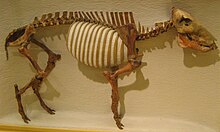| Platygonus | |
|---|---|

| |
| Platygonus compressus skeleton at Harvard University | |
| Scientific classification | |
| Domain: | Eukaryota |
| Kingdom: | Animalia |
| Phylum: | Chordata |
| Class: | Mammalia |
| Order: | Artiodactyla |
| Family: | Tayassuidae |
| Genus: | †Platygonus LeConte 1848 |
| Type species | |
| †Platygonus compressus LeConte 1848
| |
| Species | |
|
See text | |
| Synonyms | |
Platygonus ("flat head" in reference to the straight shape of the forehead)[1] is an extinct genus of herbivorous peccaries of the family Tayassuidae, endemic to North and South America from the Miocene through Pleistocene epochs (10.3 million to 11,000 years ago), existing for about 10.289 million years.[2] P. compressus stood 2.5 feet (0.76 meters) tall.[3][4]

- ^ "Peccary". Idaho Museum of Natural History. November 2002. Retrieved 1 July 2013.
- ^ Cite error: The named reference
Paleodb-42437was invoked but never defined (see the help page). - ^ Perry, Tahlia; van Loenen, Ayla L.; Heiniger, Holly; Lee, Carol; Gongora, Jaime; Cooper, Alan; Mitchell, Kieren J. (July 2017). "Ancient DNA analysis of the extinct North American flat-headed peccary (Platygonus compressus)". Molecular Phylogenetics and Evolution. 112: 258–267. Bibcode:2017MolPE.112..258P. doi:10.1016/j.ympev.2017.03.024. ISSN 1095-9513. PMID 28363818.
- ^ "Flat-headed Peccary | Explore the Ice Age Midwest". iceage.museum.state.il.us. Retrieved 2021-08-10.